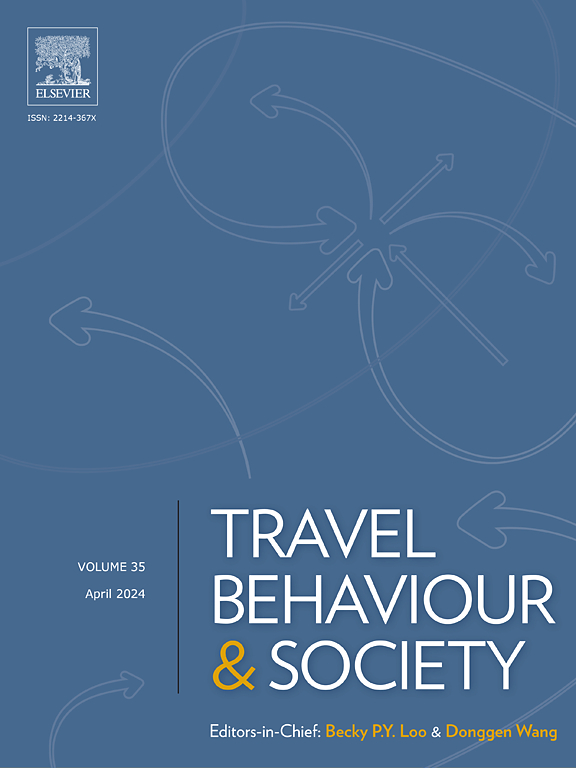Traveler preference analysis between dockless bike-sharing and electric bike-sharing in last-mile metro context: Insights from Nanjing’s urban and suburban areas
IF 5.1
2区 工程技术
Q1 TRANSPORTATION
引用次数: 0
Abstract
Dockless electric bike-sharing (DEBS), an emerging type of shared micromobility, has the potential to reshape the feeder mobility landscape that dockless bike-sharing (DBS) established in the last-mile metro context. Understanding traveler preferences between DEBS and DBS is crucial for the sustainable development of the bike-sharing feeder markets. This study sets up a context-dependent stated choice experiment to explore the critical factors that influence travelers’ choice between two bike-sharing feeder modes. It also examines whether these factors have different effects on traveler preferences in urban and suburban areas. Based on data from 402 urban respondents and 408 suburban respondents in Nanjing, China, we estimate random parameters logit models for urban and suburban areas, respectively, and find all main attributes are significant but exhibit variations across two geographical areas. Results indicate that riding distance is a critical factor in the choice between the two bike-sharing feeder modes: travelers prefer to use DBS at 800–1,500 m, while DEBS is favored at 2,500–4,000 m, especially in suburban areas. Although cost and access time also impact the probability of choosing DBS and DEBS, this influence is weaker than riding distance, as these factors do not significantly alter the “dominant riding distance” for either of the two bike-sharing feeder modes. Additionally, suburban travelers traveling for commuting purposes or with private electric bike experience are more likely to choose DEBS than DBS. The findings from this study can assist policymakers in devising targeted policy measures to promote the sustainable development of the two bike-sharing feeder modes in distinct geographical areas.
地铁最后一公里背景下无桩共享单车与电动共享单车的出行偏好分析——来自南京城市与郊区的洞察
无桩共享电动自行车(DEBS)是一种新兴的共享微型交通工具,有可能重塑无桩共享自行车(DBS)在最后一英里地铁环境中建立的馈线交通格局。了解DBS和DBS之间的旅客偏好对于共享单车馈线市场的可持续发展至关重要。本研究通过情境依赖的陈述选择实验,探讨影响两种共享单车馈线方式选择的关键因素。它还研究了这些因素是否对城市和郊区的旅行者偏好有不同的影响。基于南京402名城市受访者和408名郊区受访者的数据,我们分别对城市和郊区的随机参数logit模型进行了估计,发现所有主要属性都是显著的,但在两个地理区域之间表现出差异。结果表明,骑行距离是影响两种共享馈线模式选择的关键因素:出行者更倾向于在800 - 1500 m范围内使用DBS,而在2500 - 4000 m范围内更倾向于使用DEBS,尤其是在郊区。虽然成本和访问时间也会影响选择DBS和DEBS的概率,但这种影响弱于骑行距离,因为这些因素对两种共享馈线模式中的任何一种的“主导骑行距离”都没有显著改变。此外,以通勤为目的或有私人电动自行车经验的郊区旅行者更有可能选择DEBS而不是DBS。本研究的结果可以帮助决策者制定有针对性的政策措施,以促进两种共享单车馈线模式在不同地理区域的可持续发展。
本文章由计算机程序翻译,如有差异,请以英文原文为准。
求助全文
约1分钟内获得全文
求助全文
来源期刊

Travel Behaviour and Society
TRANSPORTATION-
CiteScore
9.80
自引率
7.70%
发文量
109
期刊介绍:
Travel Behaviour and Society is an interdisciplinary journal publishing high-quality original papers which report leading edge research in theories, methodologies and applications concerning transportation issues and challenges which involve the social and spatial dimensions. In particular, it provides a discussion forum for major research in travel behaviour, transportation infrastructure, transportation and environmental issues, mobility and social sustainability, transportation geographic information systems (TGIS), transportation and quality of life, transportation data collection and analysis, etc.
 求助内容:
求助内容: 应助结果提醒方式:
应助结果提醒方式:


